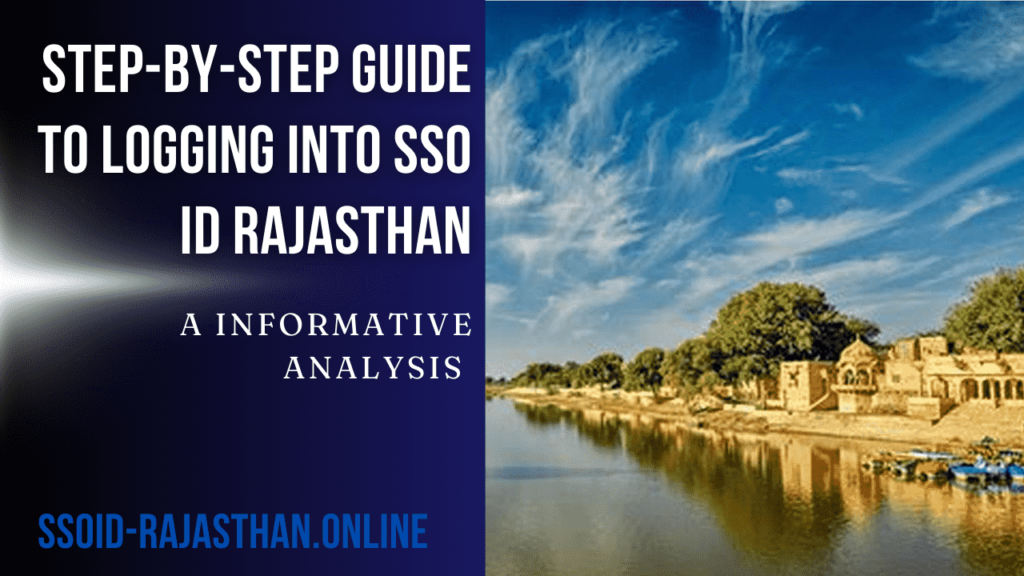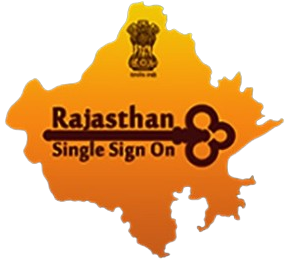This article provides a comprehensive, step-by-step guide to logging into SSO ID Rajasthan, delving into the key factors that impact the process, the tradeoffs involved in balancing these factors, and the challenges associated with different approaches. By understanding these elements, users can make informed decisions and navigate the SSO ID system effectively.
In today’s digital age, governments worldwide are embracing technology to streamline their services and enhance citizen experiences. The state of Rajasthan in India is no exception, having implemented a Single Sign-On (SSO) system to provide unified access to various government services.

The SSO ID Rajasthan platform is designed to simplify access to a multitude of state government services through a single login. This unified approach not only enhances user convenience but also improves the efficiency of service delivery. However, successfully logging into the SSO ID system requires understanding various factors that influence the process, including technical requirements, user credentials, and system security measures.
Understanding SSO ID Rajasthan
SSO ID Rajasthan is a centralized authentication system that allows users to access multiple government services with a single set of credentials. This system simplifies the user experience by eliminating the need for multiple usernames and passwords across different government portals. By streamlining the login process, it has made accessing various services more efficient and user-friendly. However, this convenience comes with its own set of challenges and considerations.
Key Factors Impacting the SSO ID Login Process
Technical Requirements:
- Internet Connectivity: A stable internet connection is paramount for accessing the SSO ID platform. Slow or unreliable connections can hinder the login process and lead to user frustration.
- Compatible Devices and Browsers: Ensuring compatibility with devices (desktops, laptops, tablets, smartphones) and browsers (Chrome, Firefox, Edge, etc.) is crucial. Certain browsers may have compatibility issues, affecting the user experience.
User Credentials:
- Registration Process: Users must register for an SSO ID by providing personal details, such as Aadhar number, Bhamashah ID, Facebook, Google, or Twitter credentials. This initial step is critical as it sets up the user’s profile and login credentials.
- Username and Password: Users need to create a secure username and password. It’s essential to follow guidelines for password strength to enhance security.
System Security Measures:
- Two-Factor Authentication (2FA): Implementing 2FA adds an extra layer of security, requiring users to verify their identity through an additional method (e.g., SMS code).
- Data Privacy and Encryption: Ensuring that user data is encrypted and securely stored is vital to protect against cyber threats.
Complete Guide to Logging into SSO ID Rajasthan
Step 1: Access the SSO ID Rajasthan Portal
- Open your preferred web browser and navigate to the official SSO ID Rajasthan website (https://sso.rajasthan.gov.in).
Step 2: Click on the ‘Login’ Button
- On the homepage, locate and click the ‘Login’ button, which will redirect you to the login page.
Step 3: Enter Your Credentials
- Username: Enter your registered username or email address.
- Password: Input your password. Ensure it is typed correctly to avoid login errors.
Step 4: Complete the CAPTCHA
- Complete the CAPTCHA verification to prove you are not a robot. This step is crucial for maintaining system security.
Step 5: Click on ‘Login’
- After entering your credentials and completing the CAPTCHA, click on the ‘Login’ button to access your SSO ID dashboard.
Step 6: Navigate Your Dashboard
- Upon successful login, you will be directed to your personalized dashboard, where you can access various government services and applications.
Tradeoffs in Balancing Different Factors
Balancing security and user convenience is a key consideration in the SSO ID login process. While robust security measures such as 2FA and CAPTCHA are essential to protect user data, they can also introduce additional steps that may be perceived as cumbersome by some users. Therefore, it is crucial to strike a balance that ensures security without significantly compromising user experience.
Security vs. Convenience
- Security Measures: Implementing strong security protocols like 2FA enhances data protection but may require users to undergo additional verification steps.
- User Experience: Simplifying the login process by minimizing steps can enhance user convenience but may reduce security levels.
Challenges Associated with Different Approaches
User Registration and Onboarding:
The initial registration process can be a barrier for less tech-savvy users. Providing clear instructions and support can help mitigate this challenge.
Technical Issues and Compatibility:
Users may encounter technical issues such as browser incompatibility or slow internet connections. Ensuring broad compatibility and offering troubleshooting support is essential.
Maintaining Security:
Balancing the need for stringent security measures with user convenience is an ongoing challenge. Continuous monitoring and updating security protocols can help address emerging threats.
Best Practices for Users
To ensure a smooth and secure login experience, users should follow these best practices:
- Use Strong Passwords: Creating a strong, unique password for the SSO ID is crucial. Avoid using easily guessable information like birthdays or common words.
- Enable Two-Factor Authentication: Whenever possible, opt for two-factor authentication. This adds an extra layer of security to your account.
- Keep Credentials Confidential: Never share your SSO ID or password with anyone, including those claiming to be government officials.
- Use Secure Devices and Networks: Logging in from personal devices on secure networks reduces the risk of credential theft.
- Regularly Update Information: Keeping contact information up-to-date ensures you can recover your account if needed and receive important notifications.
- Log Out After Each Session: Always log out after accessing services, especially on shared devices, to prevent unauthorized access to your account.
The Impact of SSO ID Rajasthan
The implementation of SSO ID Rajasthan has had a significant impact on both citizens and the government:
For Citizens:
- Simplified access to multiple government services
- Reduced need to remember multiple sets of credentials
- Improved user experience and satisfaction
For the Government:
- Enhanced security through centralized authentication
- Reduced administrative overhead in managing multiple user databases
- Improved ability to track and analyze service usage
However, the system also brings certain responsibilities and challenges for both parties. Citizens must be vigilant about their account security, while the government must ensure robust data protection measures and system reliability.
Future Developments and Considerations
As technology evolves, so too must the SSO ID Rajasthan system. Several areas for potential future development include:
- Biometric Authentication: Implementing biometric login options like fingerprint or facial recognition could further enhance security and convenience.
- Integration with National Digital ID: Aligning the SSO ID with national digital identity initiatives could provide even more streamlined access to services across different levels of government.
- Artificial Intelligence for Fraud Detection: Implementing AI-powered systems to detect and prevent fraudulent login attempts could significantly enhance security.
- Blockchain for Enhanced Security: Exploring blockchain technology for secure data storage and transaction logging could provide additional layers of security and transparency.
Final Lines
Logging into the SSO ID Rajasthan platform is a straightforward process when users are aware of the key factors and steps involved. By understanding the technical requirements, user credentials, and security measures, users can navigate the login process with ease. Balancing security and convenience, addressing challenges proactively, and considering the broader impact are essential for maintaining a seamless and secure SSO ID system. With this comprehensive guide, users can confidently access the services they need and contribute to a more efficient digital governance framework in Rajasthan.
By following this step-by-step guide and understanding the associated factors, users can ensure a smooth and secure login experience on the SSO ID Rajasthan platform.
What is SSO ID Rajasthan and why do I need it?
SSO ID Rajasthan is a Single Sign-On system implemented by the Rajasthan government to provide unified access to various state government services. By using a single set of credentials, users can log in once and access multiple services without needing separate usernames and passwords for each. This system simplifies the process and improves user convenience.
How do I register for an SSO ID?
To register for an SSO ID, visit the official SSO ID Rajasthan portal at https://sso.rajasthan.gov.in. Click on the “Register” button and provide the required personal details, such as your Aadhar number, Bhamashah ID, or social media credentials (Facebook, Google, Twitter). Follow the on-screen instructions to complete the registration process and set up your username and password.
What should I do if I forget my SSO ID password?
If you forget your SSO ID password, you can reset it by visiting the SSO ID Rajasthan portal and clicking on the “Forgot Password” link. You will be prompted to enter your registered email address or mobile number. Follow the instructions sent to your email or mobile to reset your password and regain access to your account.
Why am I facing login issues despite entering the correct credentials?
Internet Connectivity: Ensure you have a stable internet connection.
Browser Compatibility: Use a compatible and up-to-date browser (Chrome, Firefox, Edge, etc.).
CAPTCHA Verification: Complete the CAPTCHA verification correctly to prove you are not a robot.
Two-Factor Authentication (2FA): If 2FA is enabled, ensure you enter the correct one-time password (OTP) sent to your registered mobile number or email.
How can I enhance the security of my SSO ID account?
To enhance the security of your SSO ID account, follow these best practices:
Use Strong Passwords: Create a strong and unique password, avoiding easily guessable information.
Enable Two-Factor Authentication (2FA): Opt for 2FA to add an extra layer of security.
Keep Credentials Confidential: Do not share your SSO ID or password with anyone.
Use Secure Devices and Networks: Log in from personal devices on secure networks.
Log Out After Each Session: Always log out after accessing services, especially on shared devices.
